While the only thing that could actually sink a ship was flooding, fire could leave it a gutted, useless hulk, or reach something explosive, which could let water in. This flammability may seem counterintuitive, as the main ingredient in a warship is steel, but many things inside the ship need to be made of flammable substances to allow the ship to function. As a result, designers have always gone to great lengths to reduce the risk of fire, and to give the crew the tools required to fight those that broke out, whether from enemy action or accident.
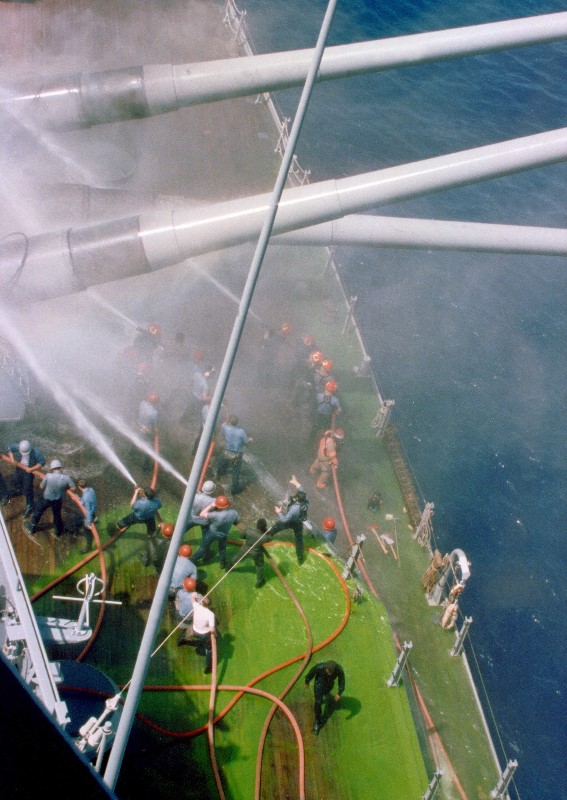
Iowa's crew fights the fire after the explosion in Turret II
The first step in this process was to reduce as far as possible the amount of combustible material onboard. During WWII, it was found that many fittings installed in peacetime to make life more comfortable were dangerous in action. Cork insulation, upholstered furniture, linoleum, and clothing not stored in metal lockers all fed fires that ultimately led to loss of life and ships, most notably in the battles off Guadalcanal. These were all ruthlessly stripped from ships, and those flammables that could not be removed were either limited or packaged in such a way as to reduce the risk.1
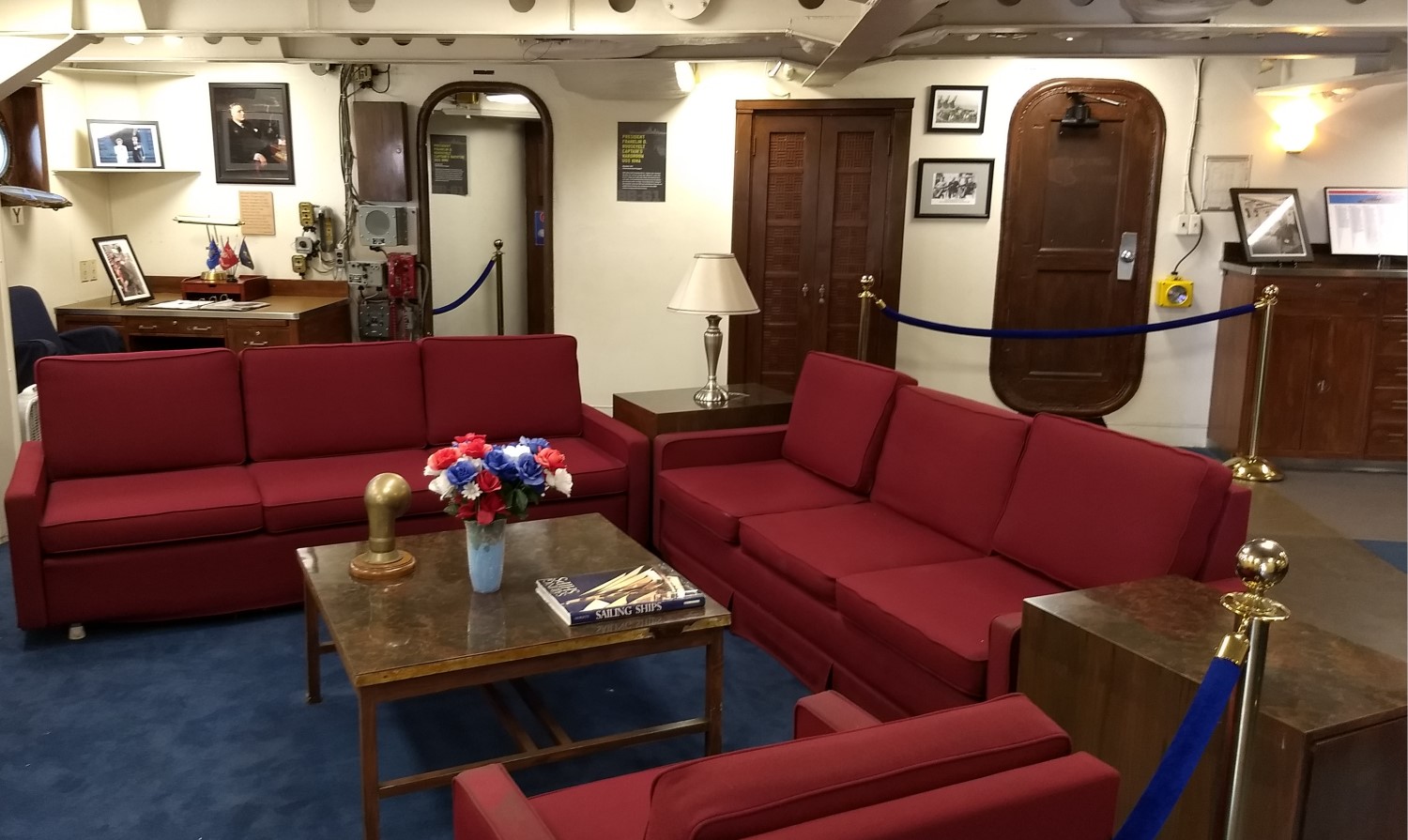
All of the "wood" in Iowa's Captain's Cabin is actually painted metal2
The crew's bedding was stored in fireproof bags, while lubricating oils and office paper were limited to the minimum necessary. Supplies in wooden crates or cardboard boxes were to be unpackaged when brought aboard, so the packing material could be disposed of ashore. Fabric curtains were replaced with glass-fiber equivalents. One of the most dangerous substances aboard was the liquid paint in the paint locker, and ships were entirely banned from carrying it. But even when dry, paint remained a threat, as American cruisers learned the hard way off Guadalcanal. Ships headed for the South Pacific were ordered to strip off accumulated layers of paint,3 and paints that were fire-resistant when dry were developed. Cable insulation is another common fuel, and even today military cables are fitted with fire-resistant coatings that are not common in the civilian world.
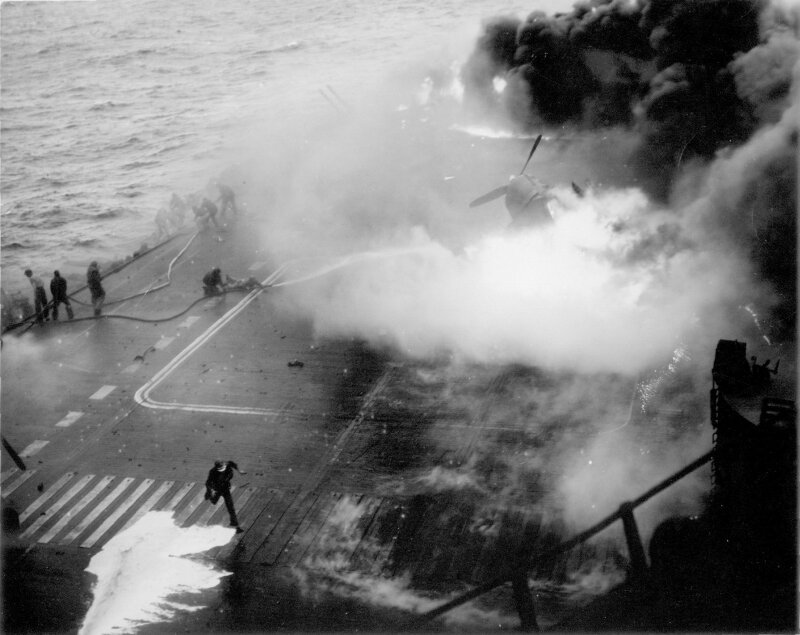
Fire after a Kamikaze hit aboard Saratoga4
A ship afire is a truly hellish place. There is scorching heat and choking smoke, and the crew is faced with a stark choice. They can either win the battle against the flames, or be pushed back into the sea. As a result, warships are equipped with a redundant firemain system, intended to provide water even if there is damage to some sections of the system.5 Spaces particularly vulnerable to fire are fitted with sprinkler systems. Hoses are hung on bulkheads throughout the ship, along with the nozzles, breathing gear, and other extinguishing systems needed to battle the blaze. Portable pumps, often known as Handy Billies, are provided in case the firemain loses pressure due to power failure or damage.
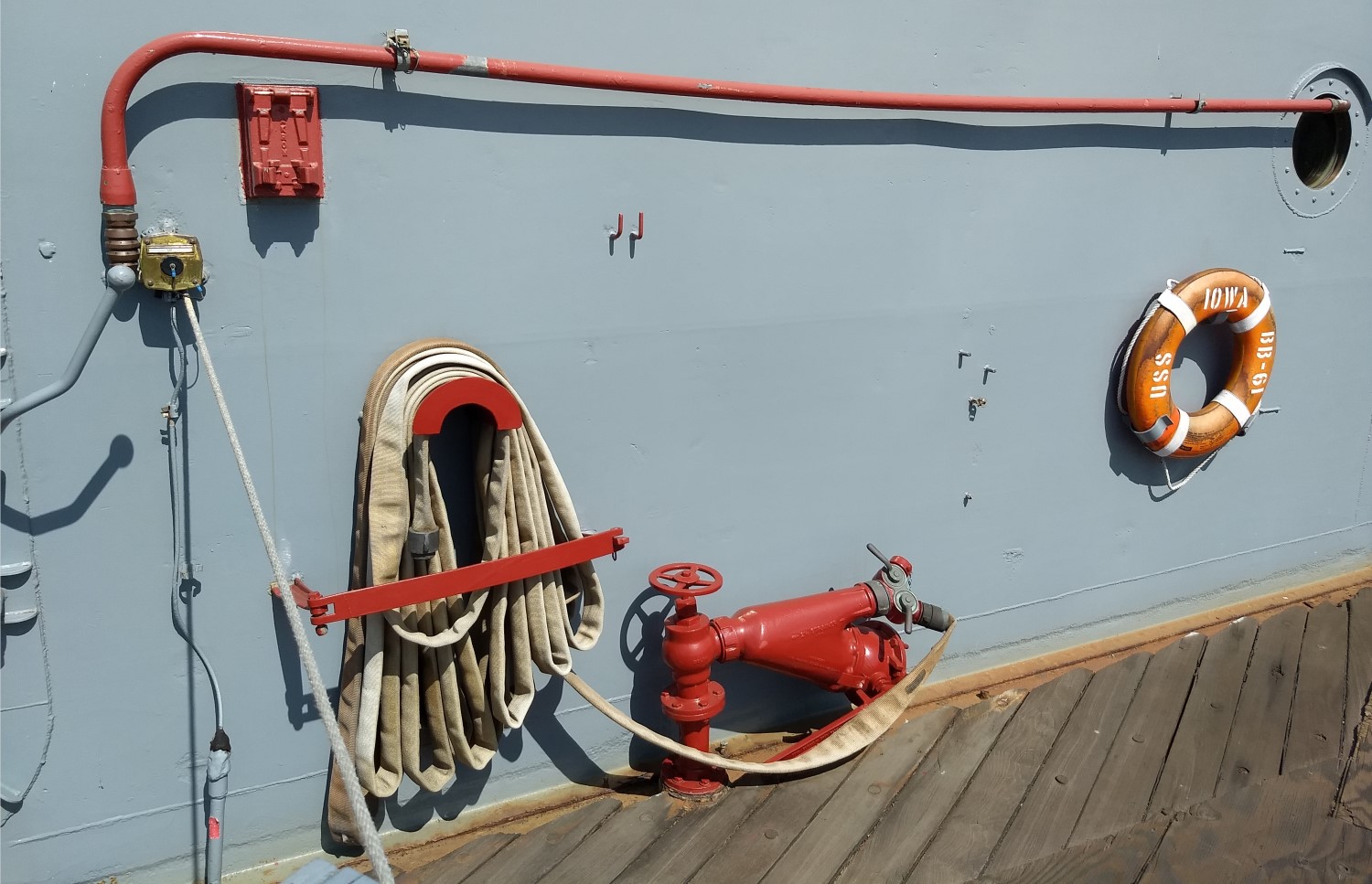
A fog applicator and hose station aboard Iowa
Naval firefighting works by attacking the classic fire triangle of heat, oxygen and fuel. Fuel removal only works in a few cases, so the firefighters are usually limited to removing heat and removing oxygen.6 Water is good at both of these, as it takes a great deal of energy to convert it into steam, and particularly in confined spaces, the resulting steam displaces oxygen. Water is applied either as a straight stream, or as fog. A stream can reach long distances and break up fires, but absorbs heat poorly and has the unfortunate side-effect of flooding the ship. Streams are also ineffective if sprayed directly at oil fires, common at sea, as the oil floats on the water. Special nozzles, known as applicators, are used to create fog. Fog is excellent at absorbing heat, which makes it effective at extinguishing oil fires and screening firefighting parties from the heat.
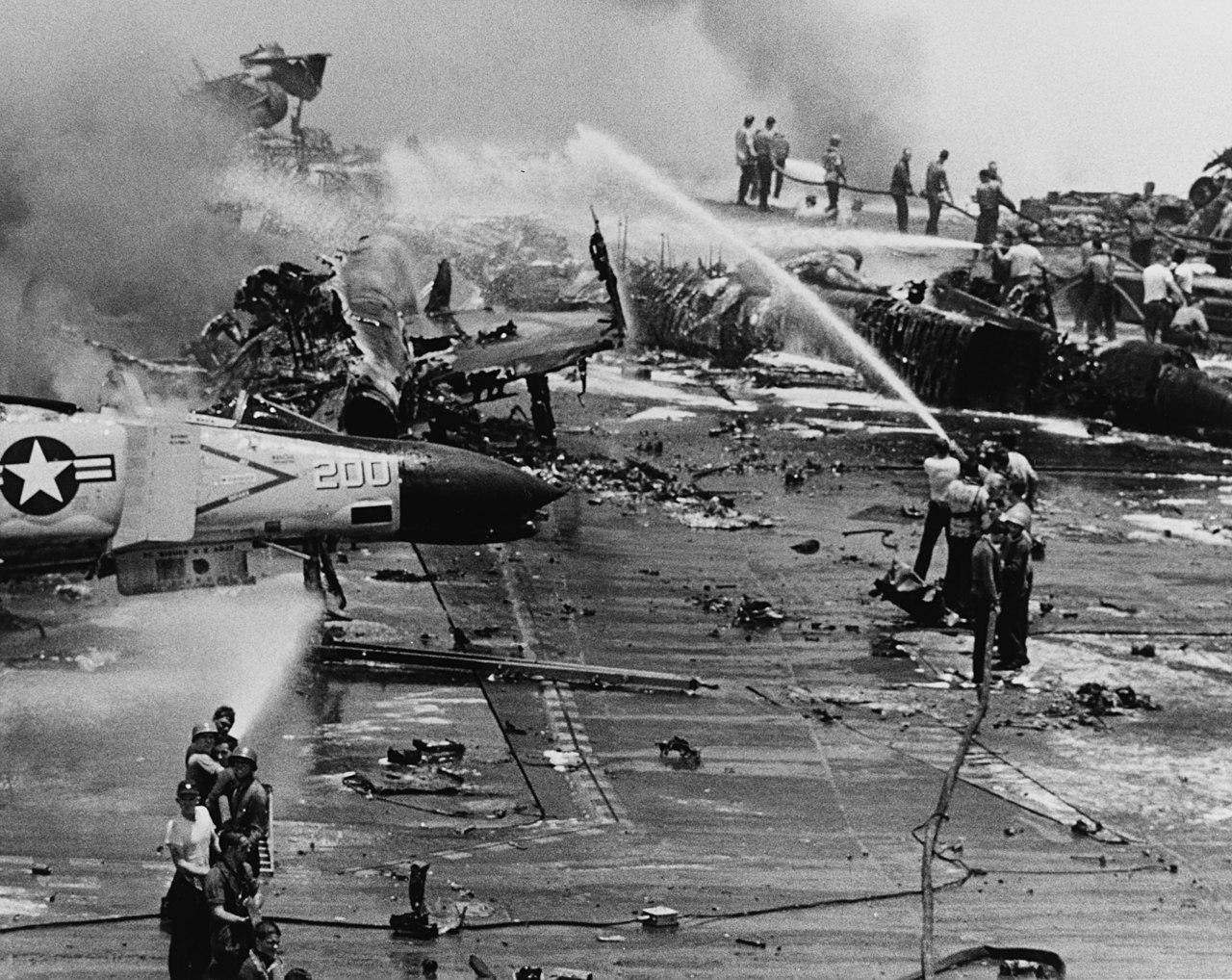
The crew of Forrestal fighting the famous fire, including the use of foam7
Even though fog is effective against oil fires, its limited range means that something else is needed to deal with them. The US Navy uses Aqueous Film-Forming Foam, known as A-triple-F. This is a special concentrate mixed with water in the nozzle, which forms a foam blanket over burning oil. This blanket cuts the oil off from oxygen and damps down the vapors that actually feed the fire. If the oil is cool enough, then it will stop the fire completely. The resulting foam also penetrates well into burning solids. However, care must be taken to avoid washing the foam blanket away through careless use of water. AFFF is often used in concert with another agent. Known in the Navy as PKP or Purple-K, it is potassium bicarbonate. It interrupts the chemical reaction that drives the fire, but does not cool or exclude oxygen, a role foam does well.
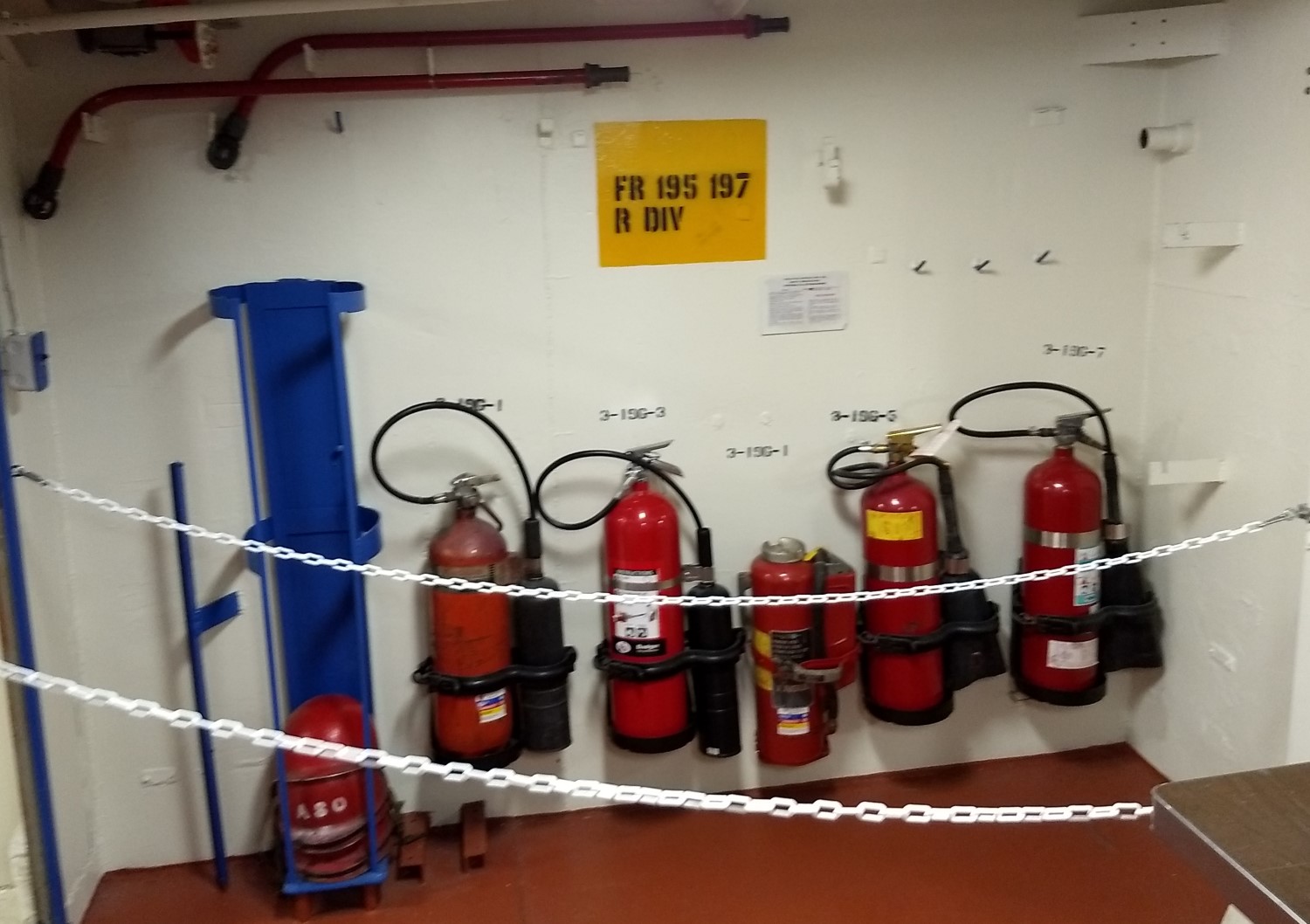
Damage control station aboard Iowa, including extinguishers
Purple-K is also used in extinguishers, particularly in galleys and other areas likely to suffer from small liquid fires. It is also effective in knocking back electrical fires long enough for the power to be cut.8 It does leave a residue, so carbon dioxide extinguishers are preferred for these fires. However CO2 does not cool well and is effective only as long as it remains in the area, excluding the oxygen the fire needs to burn.
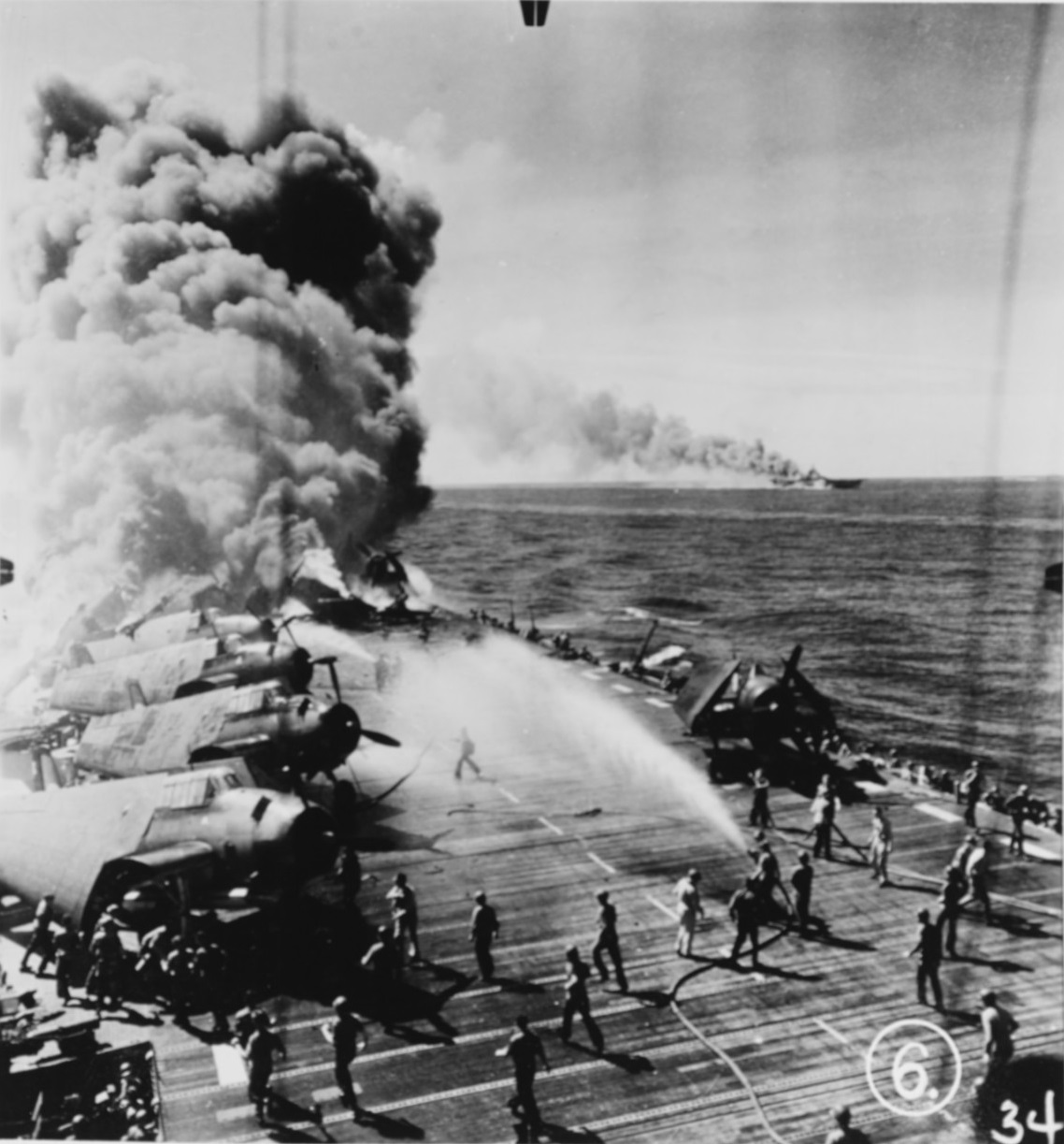
Firefighting aboard Belleau Wood after a Kamikaze attack
Initially, the fire in a compartment is small, but if it is allowed to grow, eventually a phenomenon known as flashover will occur. The various flammables in the compartment will heat up to their autoignition temperatures and suddenly the entire compartment will be enveloped in flames. At this point, the main concern is to stop the fire from spreading into other compartments. While the obvious means of containment would seem to be sealing the compartment and letting it burn out, metal conducts heat very well. This conduction can raise the temperature of neighboring compartments to the point where they start to burn and eventually experience flashovers of their own.9 Streams of water are excellent at cooling bulkheads and preventing the fire from spreading further.
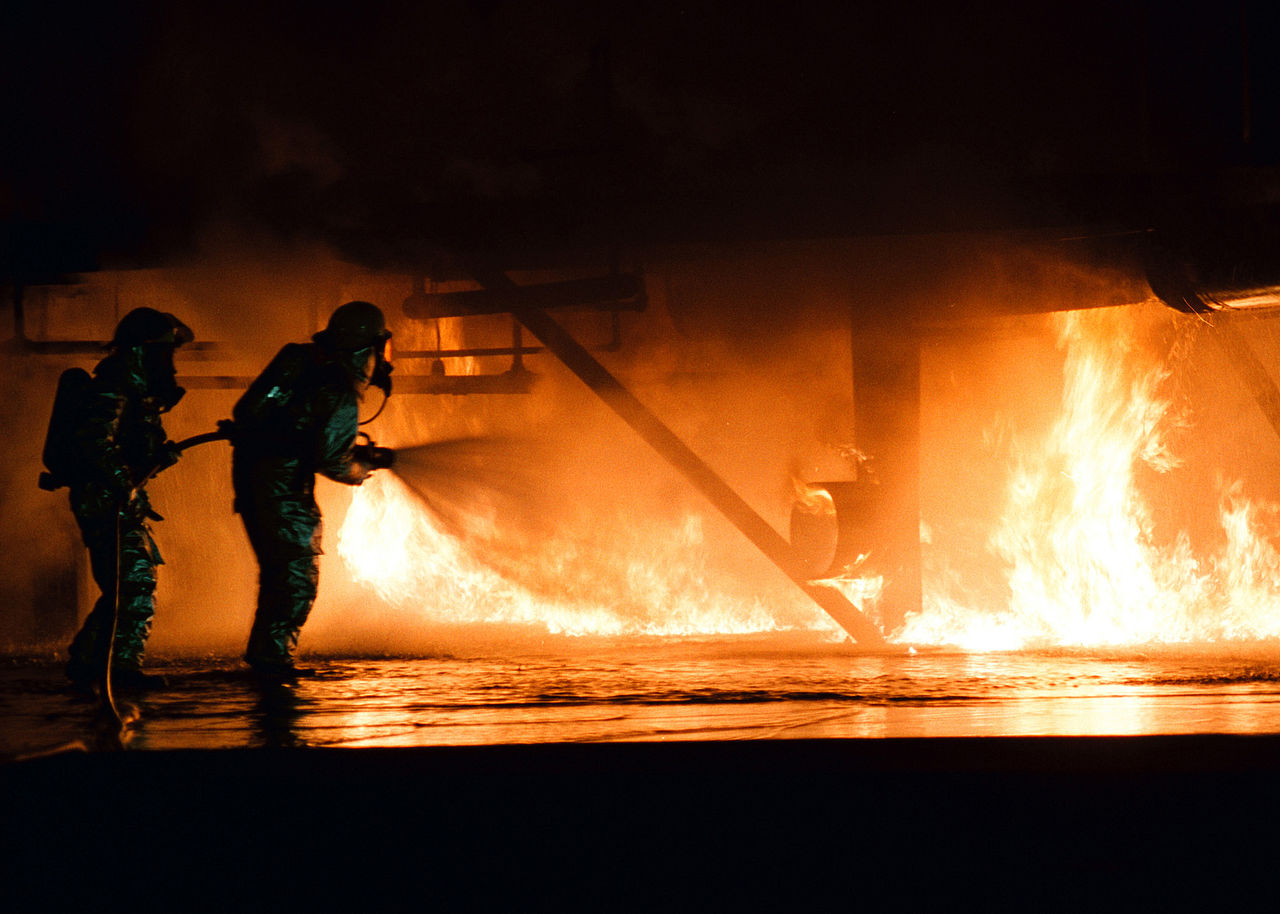
US Navy firefighter training
Fires are attacked in much the same manner as flooding. A boundary is created and the fire contained, and then compartments are gradually retaken. This is a dangerous and difficult process. Besides the heat, there is the ever-present threat of smoke, particularly as many of the materials aboard a warship produce toxic gasses when burned. Oxygen Breathing Apparatuses (OBAs)10 are provided, as are heat-resistant suits for the leading hose teams. After the fire is contained, the crew will attack, opening compartments and cooling them down. This process creates the risk of backdraft, as fires which have died down due to lack of oxygen suddenly flare up again.
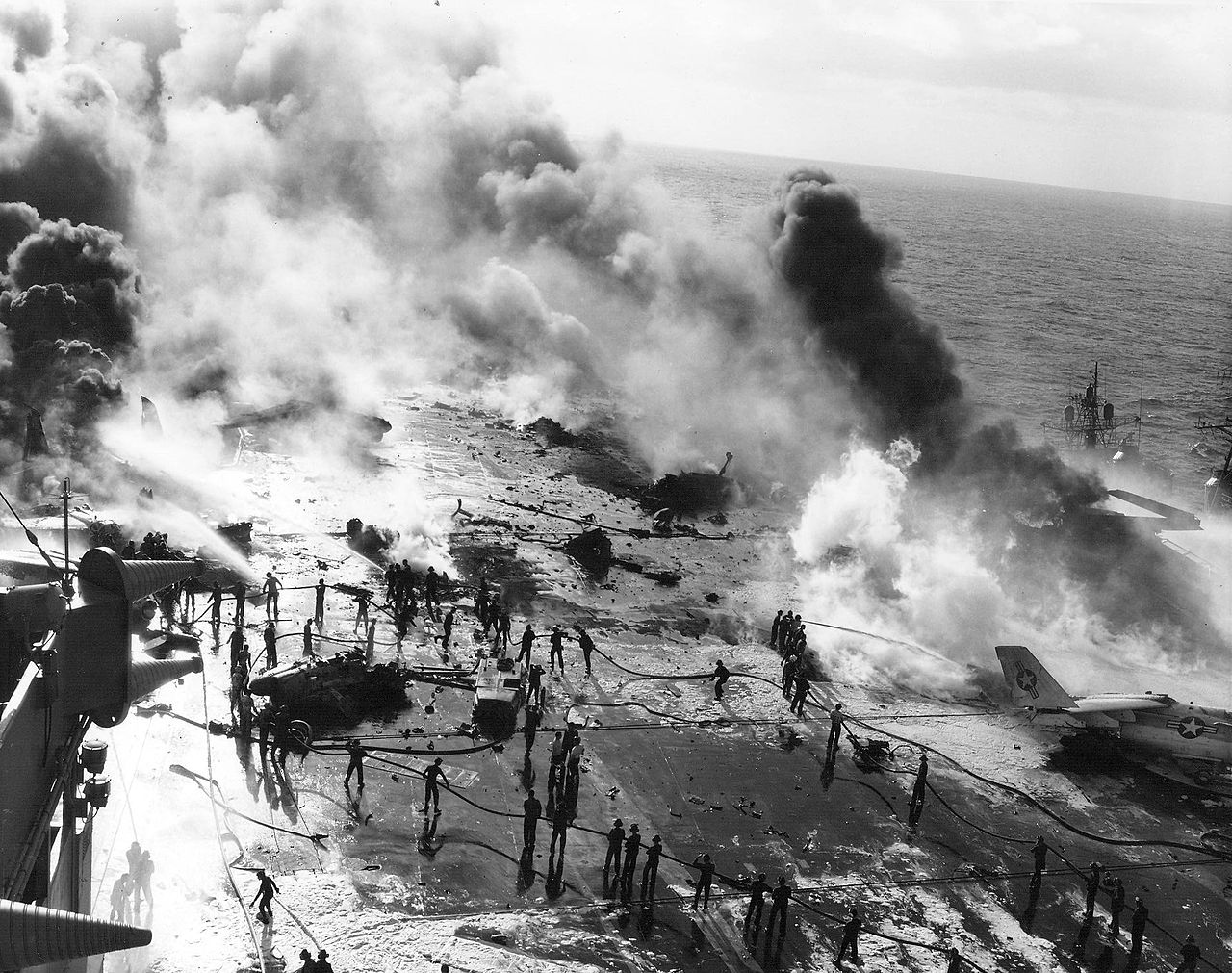
Enterprise battles an accidental fire, 1969
Fire is in many ways the greatest threat to the survival of any warship, and good navies train intensively to control and extinguish any fires that may break out. This process runs through the design and operation of the ship, hoping to prevent or mitigate fires before they start. But ultimately, the last line of defense is the crew, who must be trained, equipped and led to fight back and keep the ship alive and fighting.
1 I have no information as to why the wooden decks of battleships and cruisers were not stripped. If I had to guess, I'd say that wood out in the open is pretty easy to extinguish, while wood inside the ship is not. It's also worth noting that at least during WWI, RN practice was to wet the decks before going into battle, which undoubtedly cut the risk of fire. Doing that to flammable substances inside the ship seems less feasible. ⇑
2 This and the next two Iowa photos are mine. ⇑
3 Paint accumulation can reach impressive proportions on warships. In the late 70s, the British found up to 80 coats of paint on some frigates that were being overhauled. The 45 tons removed significantly improved stability. ⇑
4 There are a lot of carrier fire pictures for two reasons. First, carriers are incredibly flammable, due to the need to carry lots of volatile fuel and ordnance. Second, flight-deck fires are really easy to photograph compared to other kinds, and carriers have the spare hands to do so. ⇑
5 This system, filled with salt water, is vulnerable to marine life growing in it. During WWII, it had to be flushed regularly to make sure that various organisms didn't clog the pipe, although anti-fouling paints mitigated this problem later. ⇑
6 Modern ships might carry Halon fire suppression systems which chemically interrupt the combustion process, but these are fairly rare and have generally been phased out due to their effect on the ozone layer. ⇑
7 This fire is chronicled in the classic Trial By Fire: A Carrier Fights for Life, shown to decades of new sailors during basic training. ⇑
8 Despite what you might think, water can also be used for this. Modern fog nozzles have settings which produce a thin enough fog that electricity can't travel back up it, although this isn't the recommended method of dealing with these problems. ⇑
9 Modern ships have insulated fire boundaries designed to delay this process, but they were unknown during WWII. ⇑
10 Strictly speaking, OBAs are chemical oxygen generators, and the USN has switched to SCBAs, which use oxygen tanks instead. ⇑

Comments
Has flooding compartments to fight fire ever been executed, attempted, or seriously considered?
Yes, in the context of flooding magazines to keep them from blowing up. Explosions didn’t really fit in with this post, and I’ll probably discuss them independently at some point. And I’ve seen many cases of fires from underwater hits being put out by flooding from the damage. The reason deliberate flooding isn’t more common is twofold. First, most fires are above the waterline, and if that’s the case “flooding” is merely a special case of spraying water on the fire, distinguished by being really inefficient compared to normal methods. Second, it’s going to make a tremendous mess. An engine fire (the most likely case for a fire below the waterline that doesn’t involve hull damage) is not a pleasant thing, but so long as it isn’t really big, you’re better off fighting it normally because then you don’t fill all of your machinery with salt water, which is not going to go over well with the yard.
Come to thing of it, how do you deliberately flood compartments? In cases like flooding one side for balance purposes I've been assuming it's a matter of opening a path between the hull breach and the compartments you want flooded, but it sounds like you can also do this without a hull breach? Do magazines have a special mechanism for this?
For things like counterflooding, there are mechanisms built in. While a few Russian ships did it via a system that let flooding go under the bottom, it's usually done via the ship's pumps and piping. There are dozens of control panels on the Iowa for moving fluids in and out of various tanks and void spaces. I'm not sure of all the details of those systems, but it was deliberate, and not just via opening a path from an existing flooding source.
Magazines do have special systems for flooding, with mechanisms to make sure that flooding can be initiated from within the magazine or outside it. I have a book with more details on this, and will take a look later.
On your note one, I recall some stories of metal decked ships (largely either merchant or merchant conversions) with metal decks that got unlivably hot in the pacific.
Oh, I have first-hand experience of that. If you go forward to the anchor windlass room on Iowa, you emerge from under the wood deck to bare metal in the compartment before you get there. On sunny days, it gets really hot, in a few cases to the point that the compartment is actively uncomfortable to be in. But destroyers didn't have wooden decks, so it can't have just been that.
I did some looking into flooding systems, although the following is only certain for British practice c 1950. Most compartments have a connection to the central suction system for dewatering, although it's apparently possible to set it to flood the compartment instead. For things like the side voids where you might be doing counterflooding, there were dedicated seacocks for each group of compartments, along with pumps for when you wanted to empty them.
Re: seawater in the engine rooms; isn't seawater the primary source of firefighting water anyway? Although I think there's probably a large difference between "spray the engines with seawater" and "completely submerge them in seawater."
Yes and yes. If there's a fire, the seawater will make a mess, and somewhat more of a mess than fresh water would have. But it's going to collect in the bilges and be pumped out. So you only have to worry about the thing on fire, anything directly around/below it, and the bilges, unless the water gets really high. This is very different from flooding the entire engine room with seawater, and keeping things submerged in it until you can clear the space.
AFFF cannot be used in conjunction with water. AFFF smothers the fire, but hose water washes the AFFF off, resulting in reignition: see lessons learned from Big E’s conflag. The only way to fight an electrical fire is to cut the power. Then you’ll be fighting an A, B, or C fire. Ex-DCA and grad of the Navy firefighting schools in early 70s.
@Jim
You're not wrong on the interaction of hose water and AFFF blankets, and for some unaccountable reason I forgot to link the classic Trial By Fire, about the Forrestal blaze. It was a staple of Navy basic training for years, and might still be used.
And you're also right about the need to cut power, even if I didn't say so explicitly. (I suspect because it seemed obvious. Still wouldn't want to use water anywhere near electrical machinery.
Fun fact, you actually can use water to fight an electrical fire (eg a switchboard) if necessary (no, seriously, it's in the 555 and everything). Modern Vari-Nozzles have a fog setting (Wide V) which won't generate enough pressure for the electrical current to go back up the stream. Note it's not recommended, just that you could do it, if nothing else was available, and it probably would do less damage than PKP anyway.
On the subject of cross-flooding: I know some of the compartments actually have voids that connect them so that as one fills up, the other will, too.
Interesting. I did not know that. This is necessarily a bit scattershot, as I had to cover about 75 years of firefighting technique from information I pieced together myself.
Regarding note #1, wasn't the wooden deck planking retained in large part as an antiskid measure? Crewmembers can get to their action stations a lot quicker if they don't have to walk slowly to keep from losing traction.
Yes, but the fraction who need to go topside to get to stations is relatively small. As much as anything, I was trying to note that I'm somewhat unsure of exactly what was going on there. Honestly, I'd put higher odds on it being that the ships would have been completely uninhabitable in the South Pacific without the insulation the deck provided, and the danger posed by fire was low enough to accept that.